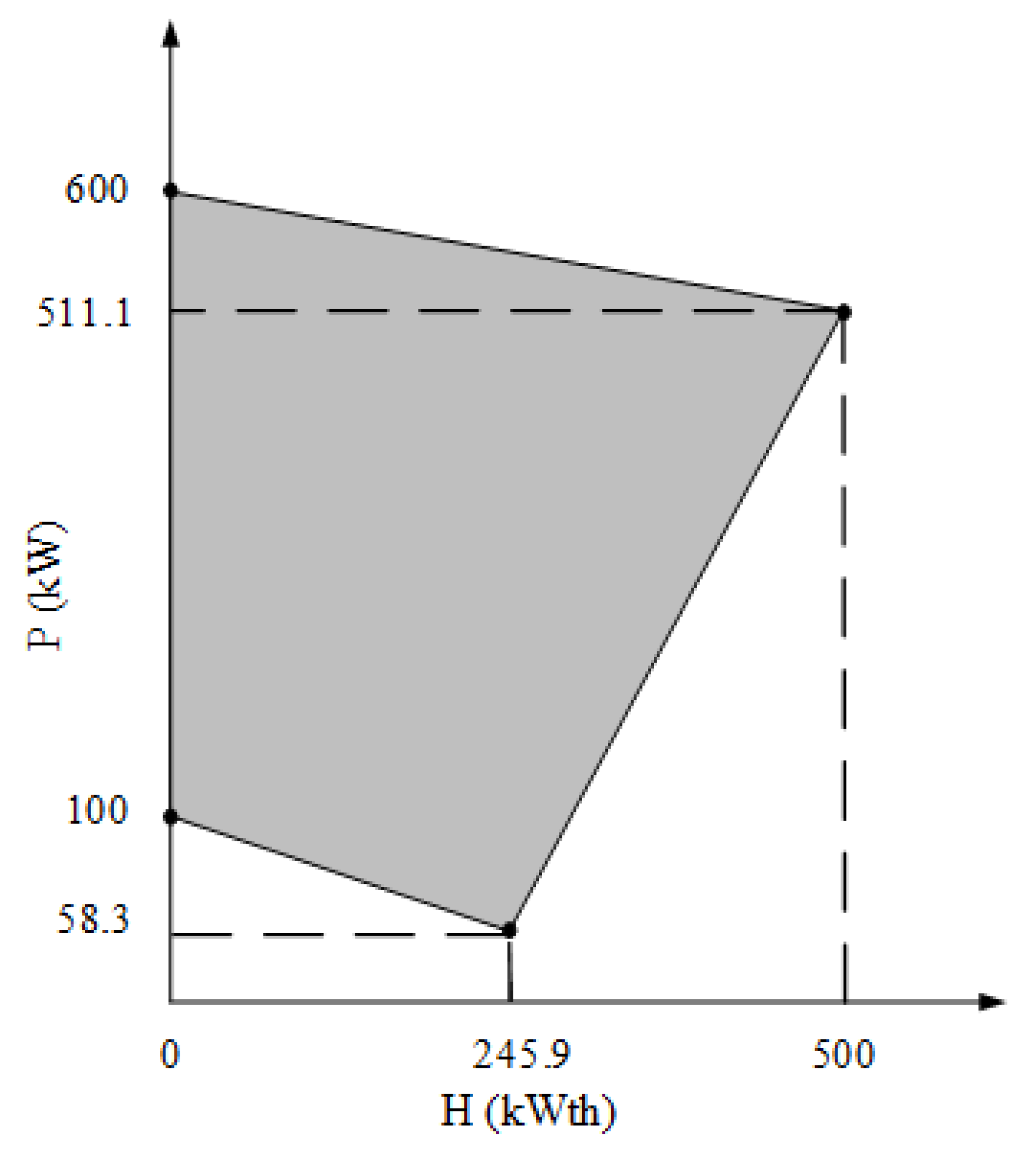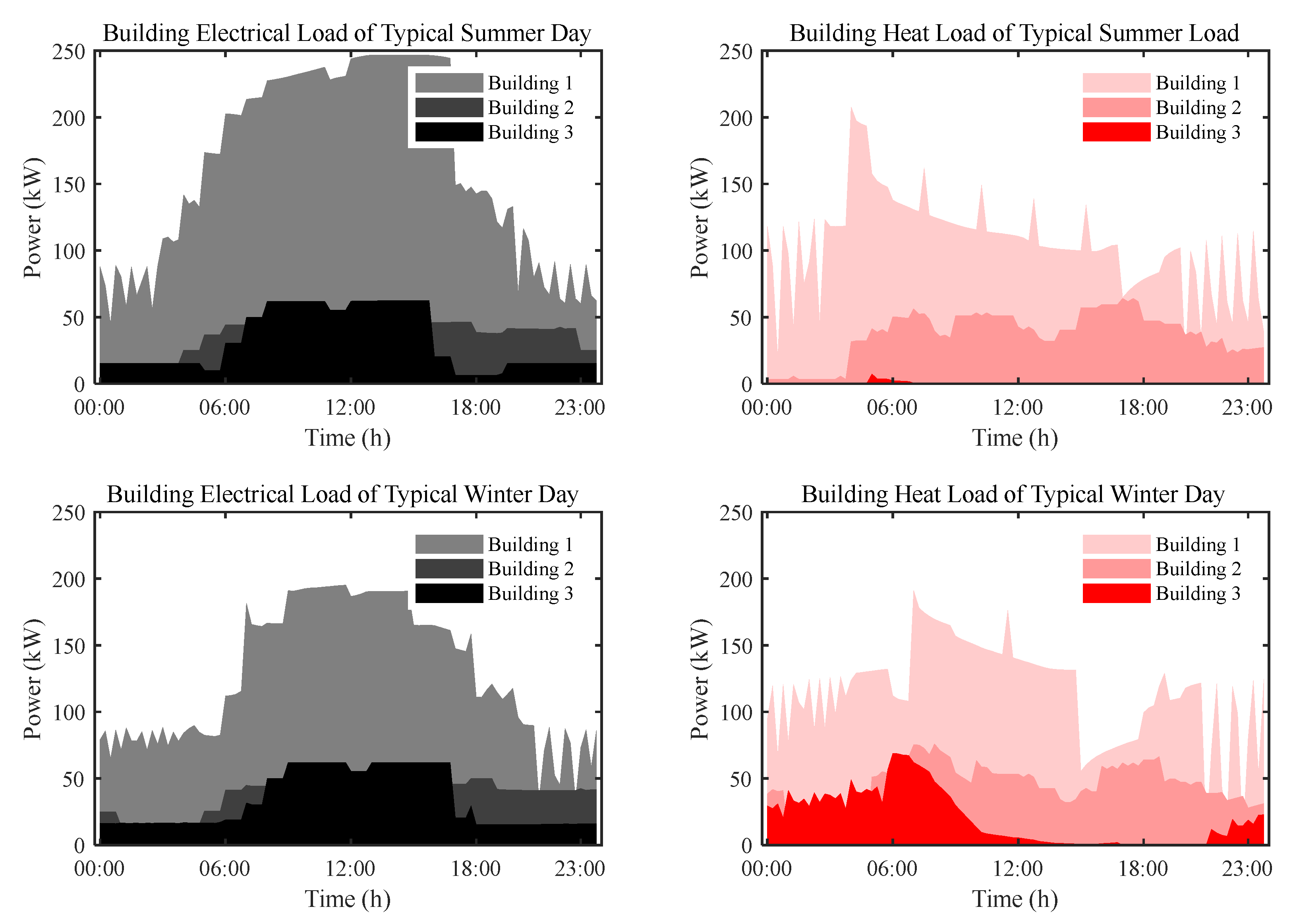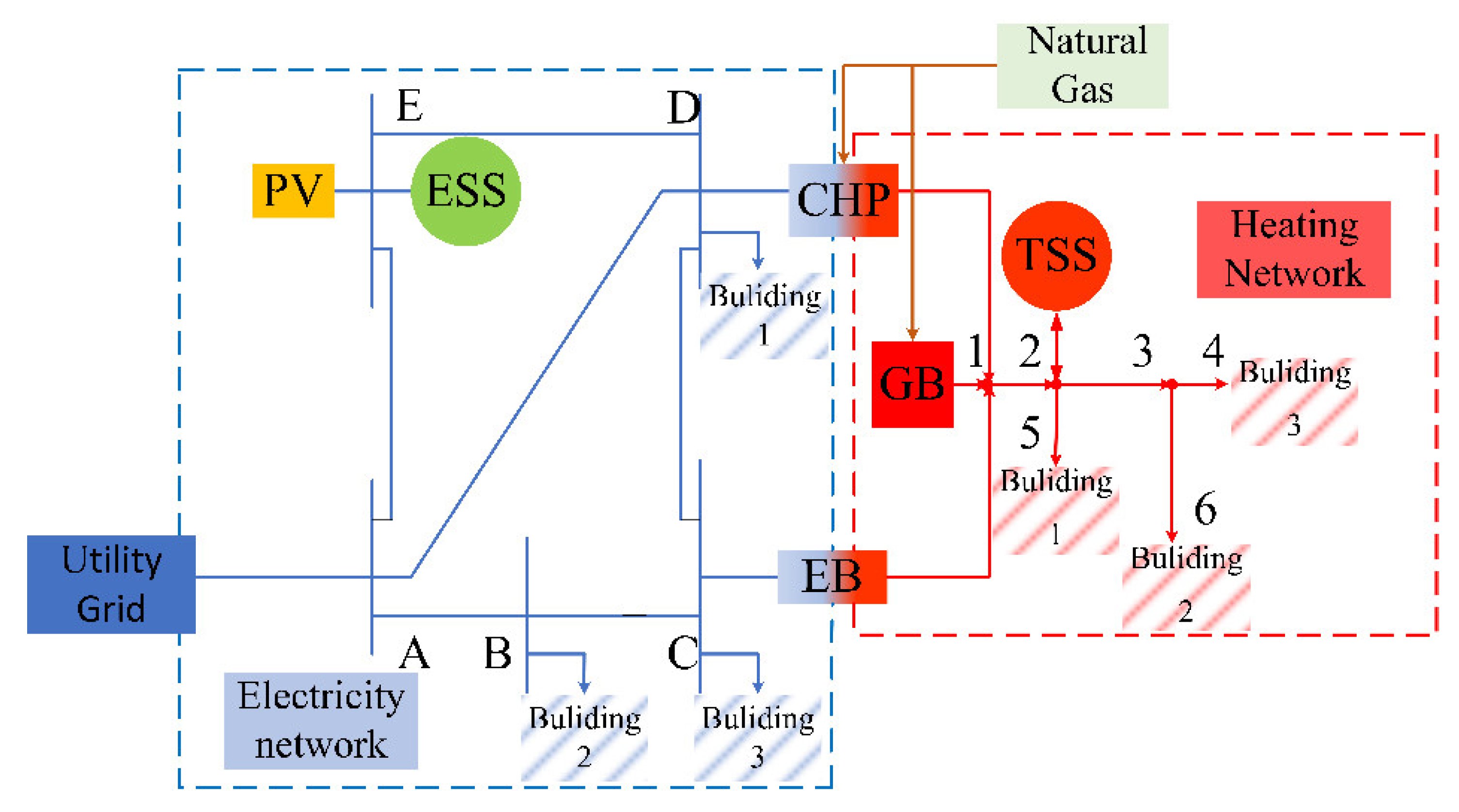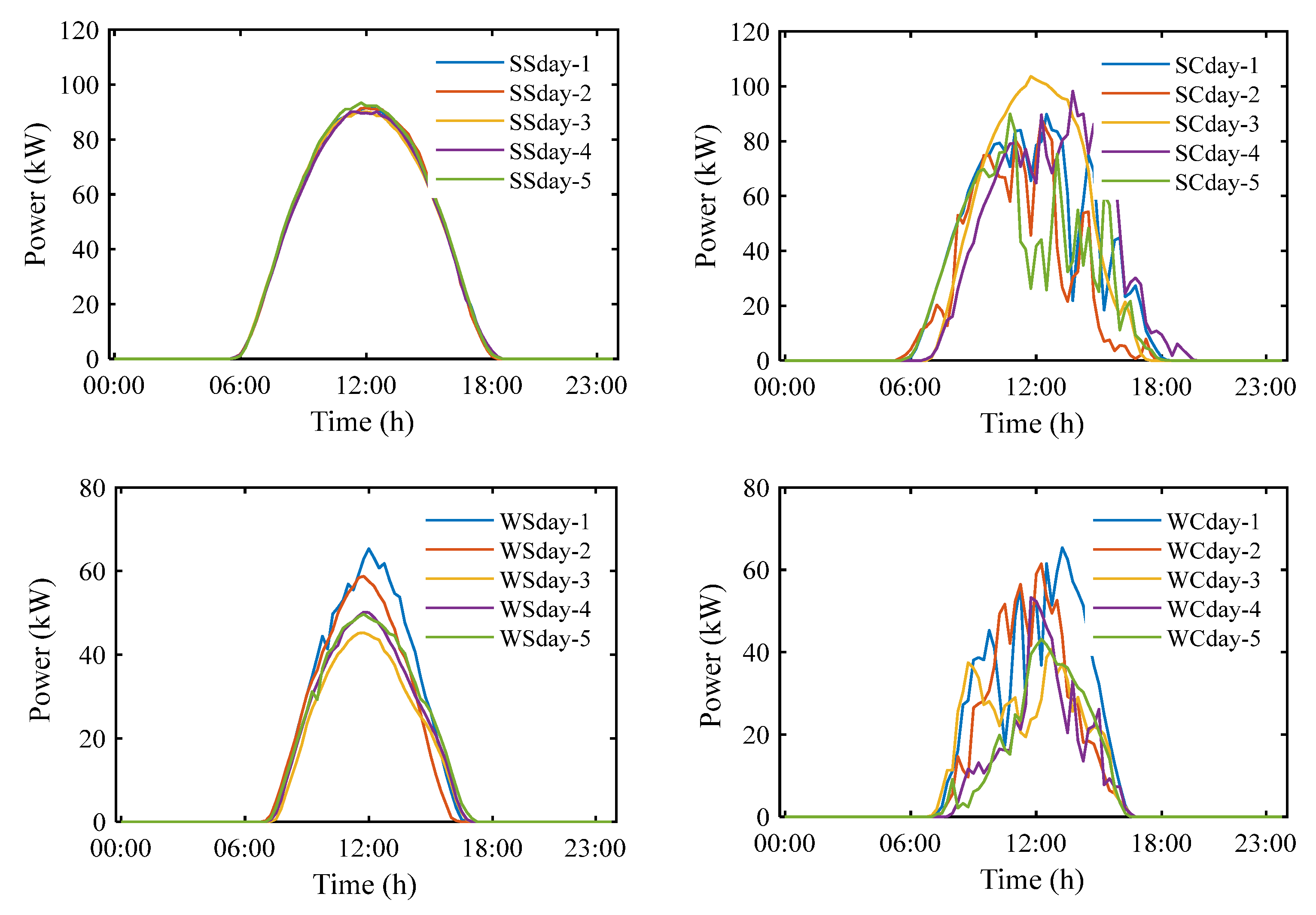Day-Ahead Optimal Scheduling of Integrated Energy System Based on Type-II Fuzzy Interval Chance-Constrained Programming
Abstract
1. Introduction
Literature Review
2. Problem Statement
2.1. Renewable Energy Multiple Uncertainty Description
2.2. Load Uncertainty Description
3. Optimal Scheduling Method of IES Based on T2FICCP
3.1. Objective Function
3.2. Constraint Condition
- IES Power Constraints
- 2.
- CHP Unit Operating Constraints
- 3.
- ESS Energy Storage Constraints
- 4.
- TSS Energy Storage Constraints
- 5.
- GB, EB, and Utility Grid Contact Line Power Constraints
3.3. Hybrid Solving Algorithm Based on ILP and T2FICCP
4. Simulation Research
4.1. System Infrastructure and Data Sources
4.2. Simulation Results and Analysis
5. Conclusions
- Compared with the traditional fuzzy and interval optimization models, the T2FICCP optimization model describes the uncertainty more comprehensively and uses different methods to describe the uncertain information according to the different uncertainty characteristics; the economic cost is better than other optimization models, which shows that the performance of T2FICCP when dealing with multiple uncertainties is better.
- In this paper, according to the intermittent characteristics of RES, a hybrid algorithm is adopted. Compared with the traditional algorithm, it can effectively reduce the dependence on uncertain factors, make the scheduling results more real and reliable, and improve the computing speed.
- The operation cost of the IES changes with the prediction accuracy, confidence level, and load prediction error, which reflects the dynamic fluctuation of the IES to the prediction error.
- This research mainly compares the operating costs of RES and load forecast errors at different confidence levels, and gives the IES scheduling plan under the optimal operating cost. The research results show that the model proposed in this paper can effectively improve the capacity of IES to consume RES, give full play to the complementary advantages of operating characteristics and operating costs of multiple energy sources and energy-using equipment, and realize the coordinated optimization of multiple energy output.
Author Contributions
Funding
Data Availability Statement
Acknowledgments
Conflicts of Interest
Appendix A

| Device | Symbol | Value |
|---|---|---|
| CHP | −0.1778 | |
| −0.1698 | ||
| 1.7819 | ||
| 600 kW | ||
| 100 kW | ||
| 500 kWth | ||
| 213.167 kWth | ||
| 0 | ||
| USD/kW2 | ||
| 0.0145 USD/kW | ||
| USD 64.37 | ||
| USD/kWth2 | ||
| 0.0042 USD/kW | ||
| USD/kW-kWth | ||
| 200 kW/h | ||
| 200 kWth/h | ||
| USD 10 | ||
| ESS | USD 7.1217 | |
| 0.99 | ||
| 200kW | ||
| 0 | ||
| 0.9 | ||
| 0.1 | ||
| 0.1 | ||
| 500 kWh | ||
| TSS | 0.87 | |
| 100 kWth | ||
| 0 | ||
| 0.9 | ||
| 0.1 | ||
| 0.1 | ||
| 500 kWth/h | ||
| GB | 0.9 | |
| 200 kWth | ||
| EB | 0.97 | |
| 150 kW | ||
| Grid | 300 kW |


References
- Gao, Q.; Zhang, X.; Yang, M.; Chen, X.; Zhou, H.; Yang, Q. Fuzzy Decision-Based Optimal Energy Dispatch for Integrated Energy Systems With Energy Storage. Front. Energy Res. 2021, 9, 809024. [Google Scholar] [CrossRef]
- Wang, Y.; Yu, H.; Yong, M.; Huang, Y.; Zhang, F.; Wang, X. Optimal Scheduling of Integrated Energy Systems with Combined Heat and Power Generation, Photovoltaic and Energy Storage Considering Battery Lifetime Loss. Energies 2018, 11, 1676. [Google Scholar] [CrossRef]
- Zhang, Y.; He, Y.; Yan, M.; Guo, C.; Ding, Y. Linearized Stochastic Scheduling of Interconnected Energy Hubs Considering Integrated Demand Response and Wind Uncertainty. Energies 2018, 11, 2448. [Google Scholar] [CrossRef]
- Gao, J.; Yang, Y.; Gao, F.; Wu, H. Two-Stage Robust Economic Dispatch of Regional Integrated Energy System Considering Source-Load Uncertainty Based on Carbon Neutral Vision. Energies 2022, 15, 1596. [Google Scholar] [CrossRef]
- Wang, W.; Dong, H.; Luo, Y.; Zhang, C.; Zeng, B.; Xu, F.; Zeng, M. An Interval Optimization-Based Approach for Electric–Heat–Gas Coupled Energy System Planning Considering the Correlation between Uncertainties. Energies 2021, 14, 2457. [Google Scholar] [CrossRef]
- Zhou, C.; Huang, G.; Chen, J. A Type-2 Fuzzy Chance-Constrained Fractional Integrated Modeling Method for Energy System Management of Uncertainties and Risks. Energies 2019, 12, 2472. [Google Scholar] [CrossRef]
- Oh, U.; Lee, Y.; Choi, J.; Karki, R. Reliability evaluation of power system considering wind generators coordinated with multi-energy storage systems. IET Gener. Transm. Distrib. 2020, 14, 786–796. [Google Scholar] [CrossRef]
- Zhang, D.; Jiang, S.; Liu, J.; Wang, L.; Chen, Y.; Xiao, Y.; Jiao, S.; Xie, Y.; Zhang, Y.; Li, M. Stochastic Optimization Operation of the Integrated Energy System Based on a Novel Scenario Generation Method. Processes 2022, 10, 330. [Google Scholar] [CrossRef]
- Liu, G.; Starke, M.; Xiao, B.; Zhang, X.; Tomsovic, K. Microgrid optimal scheduling with chance-constrained islanding capability. Electr. Power Syst. Res. 2017, 145, 197–206. [Google Scholar] [CrossRef]
- Zhao, P.; Gu, C.; Huo, D.; Shen, Y.; Hernando-Gil, I. Two-Stage Distributionally Robust Optimization for Energy Hub Systems. IEEE Trans. Ind. Inform. 2020, 16, 3460–3469. [Google Scholar] [CrossRef]
- Zhang, Y.; Le, J.; Zheng, F.; Zhang, Y.; Liu, K. Two-stage distributionally robust coordinated scheduling for gas-electricity integrated energy system considering wind power uncertainty and reserve capacity configuration. Renew. Energy 2019, 135, 122–135. [Google Scholar] [CrossRef]
- Tan, Z.; Tan, Q.; Yang, S.; Ju, L.; De, G. A Robust Scheduling Optimization Model for an Integrated Energy System with P2G Based on Improved CVaR. Energies 2018, 11, 3437. [Google Scholar] [CrossRef]
- Li, Y.; Wang, K.; Gao, B.; Zhang, B.; Liu, X.; Chen, C. Interval optimization based operational strategy of integrated energy system under renewable energy resources and loads uncertainties. Int. J. Energy Res. 2020, 45, 3142–3156. [Google Scholar] [CrossRef]
- Aslam, S.; Khalid, A.; Javaid, N. Towards efficient energy management in smart grids considering microgrids with day-ahead energy forecasting. Electr. Power Syst. Res. 2020, 182, 106232. [Google Scholar] [CrossRef]
- Bai, L.; Li, F.; Cui, H.; Jiang, T.; Sun, H.; Zhu, J. Interval optimization based operating strategy for gas-electricity integrated energy systems considering demand response and wind uncertainty. Appl. Energy 2016, 167, 270–279. [Google Scholar] [CrossRef]
- Liu, H.; Tian, S.; Wang, X.; Cao, Y.; Zeng, M.; Li, Y. Optimal Planning Design of a District-Level Integrated Energy System Considering the Impacts of Multi-Dimensional Uncertainties: A Multi-Objective Interval Optimization Method. IEEE Access 2021, 9, 26278–26289. [Google Scholar] [CrossRef]
- Li, Z.; Zhang, Z. Day-Ahead and Intra-Day Optimal Scheduling of Integrated Energy System Considering Uncertainty of Source & Load Power Forecasting. Energies 2021, 14, 2539. [Google Scholar] [CrossRef]
- Zhou, C.; Huang, G.; Chen, J. A Multi-Objective Energy and Environmental Systems Planning Model: Management of Uncertainties and Risks for Shanxi Province, China. Energies 2018, 11, 2723. [Google Scholar] [CrossRef]
- Doan, A.T.; Viet, D.T.; Duong, M.Q. Economic load dispatch solutions considering multiple fuels for thermal units and generation cost of wind turbines. Int. J. Electr. Comput. Eng. 2021, 11, 3718–3726. [Google Scholar] [CrossRef]
- Waseem, M.; Lin, Z.; Liu, S.; Zhang, Z.; Aziz, T.; Khan, D. Fuzzy compromised solution-based novel home appliances scheduling and demand response with optimal dispatch of distributed energy resources. Appl. Energy 2021, 290, 116761. [Google Scholar] [CrossRef]
- Liu, X.; Xie, S.; Geng, C.; Yin, J.; Xiao, G.; Cao, H. Optimal Evolutionary Dispatch for Integrated Community Energy Systems Considering Uncertainties of Renewable Energy Sources and Internal Loads. Energies 2021, 14, 3644. [Google Scholar] [CrossRef]
- Guo, X.; Gong, R.; Bao, H.; Wang, Q. Hybrid Stochastic and Interval Power Flow Considering Uncertain Wind Power and Photovoltaic Power. IEEE Access 2019, 7, 85090–85097. [Google Scholar] [CrossRef]
- Liu, Z.; Huang, G.; Li, W. An inexact stochastic–fuzzy jointed chance-constrained programming for regional energy system management under uncertainty. Eng. Optim. 2014, 47, 788–804. [Google Scholar] [CrossRef]
- Mohammadi, M.; Noorollahi, Y.; Mohammadi-ivatloo, B. Fuzzy-based scheduling of wind integrated multi-energy systems under multiple uncertainties. Sustain. Energy Technol. Assess. 2020, 37, 100602. [Google Scholar] [CrossRef]
- Zhen, J.L.; Huang, G.H.; Li, W.; Liu, Z.P.; Wu, C.B. An inexact optimization model for regional electric system steady operation management considering integrated renewable resources. Energy 2017, 135, 195–209. [Google Scholar] [CrossRef]
- Wang, K.; Qi, X.; Liu, H. Photovoltaic power forecasting-based LSTM-Convolutional Network. Energy 2019, 189, 116225. [Google Scholar] [CrossRef]
- Han, S.; Qiao, Y.-H.; Yan, J.; Liu, Y.-Q.; Li, L.; Wang, Z. Mid-to-long term wind and photovoltaic power generation prediction based on copula function and long short term memory network. Appl. Energy 2019, 239, 181–191. [Google Scholar] [CrossRef]
- Yin, J.; Zhao, D. Fuzzy Stochastic Unit Commitment Model with Wind Power and Demand Response under Conditional Value-At-Risk Assessment. Energies 2018, 11, 341. [Google Scholar] [CrossRef]
- Mendel, J.M.; John, R.I. Type-2 fuzzy sets made simple. IEEE Trans. Fuzzy Syst. 2001, 10, 117–127. [Google Scholar] [CrossRef]
- Guerrero, J.M.; Chandorkar, M.; Lee, T.-L.; Loh, P.C. Advanced Control Architectures for Intelligent Microgrids-Part I: Decentralized and Hierarchical Control. IEEE Trans. Ind. Electron. 2013, 60, 1254–1262. [Google Scholar] [CrossRef]
- Khalid, R.; Javaid, N.; Rahim, M.H.; Aslam, S.; Sher, A. Fuzzy energy management controller and scheduler for smart homes. Sustain. Comput. Inform. Syst. 2019, 21, 103–118. [Google Scholar] [CrossRef]
- Siahkali, H.; Vakilian, M. Interval type-2 fuzzy modeling of wind power generation in Genco’s generation scheduling. Electr. Power Syst. Res. 2011, 81, 1696–1708. [Google Scholar] [CrossRef]
- Mamun, A.A.; Sohel, M.; Mohammad, N.; Haque Sunny, M.S.; Dipta, D.R.; Hossain, E. A Comprehensive Review of the Load Forecasting Techniques Using Single and Hybrid Predictive Models. IEEE Access 2020, 8, 134911–134939. [Google Scholar] [CrossRef]
- Ji, L.; Niu, D.X.; Xu, M.; Huang, G.H. An optimization model for regional micro-grid system management based on hybrid inexact stochastic-fuzzy chance-constrained programming. Int. J. Electr. Power Energy Syst. 2015, 64, 1025–1039. [Google Scholar] [CrossRef]
- Liu, J.; Nie, S.; Shan, B.G.; Li, Y.P.; Huang, G.H.; Liu, Z.P. Development of an interval-credibility-chance constrained energy-water nexus system planning model—A case study of Xiamen, China. Energy 2019, 181, 677–693. [Google Scholar] [CrossRef]
- Li, Y.P.; Nie, S.; Huang, C.Z.; McBean, E.A.; Fan, Y.R.; Huang, G.H. An Integrated Risk Analysis Method for Planning Water Resource Systems to Support Sustainable Development of an Arid Region. J. Environ. Inform. 2017, 29, 1–15. [Google Scholar] [CrossRef]
- Kundu, P.; Majumder, S.; Kar, S.; Maiti, M. A method to solve linear programming problem with interval type-2 fuzzy parameters. Fuzzy Optim. Decis. Mak. 2018, 18, 103–130. [Google Scholar] [CrossRef]
- Zheng, L.; Zhou, X.; Qiu, Q.; Yang, L. Day-ahead optimal dispatch of an integrated energy system considering time-frequency characteristics of renewable energy source output. Energy 2020, 209, 118434. [Google Scholar] [CrossRef]
- Li, G.; Zhang, R.; Jiang, T.; Chen, H.; Bai, L.; Cui, H.; Li, X. Optimal dispatch strategy for integrated energy systems with CCHP and wind power. Appl. Energy 2017, 192, 408–419. [Google Scholar] [CrossRef]
- Jin, M.; Feng, W.; Liu, P.; Marnay, C.; Spanos, C. MOD-DR: Microgrid optimal dispatch with demand response. Appl. Energy 2017, 187, 758–776. [Google Scholar] [CrossRef]
- Divya, K.C.; Østergaard, J. Battery energy storage technology for power systems—An overview. Electr. Power Syst. Res. 2009, 79, 511–520. [Google Scholar] [CrossRef]






| Typical Days | Model-1 (USD) | Model-2 (USD) | T2FICCP (USD) |
|---|---|---|---|
| SSday-1 | 1273.6 | 1276.1 | 1254.9 |
| SCday-4 | 1285.4 | 1288.1 | 1267.3 |
| WSday-1 | 1329.3 | 1334.5 | 1315.8 |
| WCday-1 | 1342.6 | 1348.7 | 1329.6 |
| β | Model-1 (USD) | Model-2 (USD) | T2FICCP (USD) |
|---|---|---|---|
| 0.95 | 1285.4 | 1288.1 | 1271.9 |
| 0.9 | 1283.8 | 1285.9 | 1271.1 |
| 0.85 | 1282.1 | 1283.7 | 1270.6 |
| 0.8 | 1280.3 | 1281.6 | 1270.1 |
| Load Prediction Error | Model-1 (USD) | Model-2 (USD) | T2FICCP (USD) |
|---|---|---|---|
| 0.05 | 1278.1 | 1288.1 | 1271.9 |
| 0.1 | 1290.7 | 1299.8 | 1275.1 |
| 0.15 | 1302.3 | 1327.5 | 1305.6 |
| 0.2 | 1316.1 | 1346.3 | 1310.2 |
| PV Prediction Error | Model-1 (USD) | Model-2 (USD) | T2FICCP (USD) |
|---|---|---|---|
| 0.05 | 1278.1 | 1288.1 | 1271.9 |
| 0.1 | 1281.9 | 1289.1 | 1274.1 |
| 0.15 | 1284.5 | 1290.5 | 1277.1 |
| 0.2 | 1289.1 | 1292.1 | 1280.1 |
Publisher’s Note: MDPI stays neutral with regard to jurisdictional claims in published maps and institutional affiliations. |
© 2022 by the authors. Licensee MDPI, Basel, Switzerland. This article is an open access article distributed under the terms and conditions of the Creative Commons Attribution (CC BY) license (https://creativecommons.org/licenses/by/4.0/).
Share and Cite
Sun, X.; Wu, H.; Guo, S.; Zheng, L. Day-Ahead Optimal Scheduling of Integrated Energy System Based on Type-II Fuzzy Interval Chance-Constrained Programming. Energies 2022, 15, 6763. https://doi.org/10.3390/en15186763
Sun X, Wu H, Guo S, Zheng L. Day-Ahead Optimal Scheduling of Integrated Energy System Based on Type-II Fuzzy Interval Chance-Constrained Programming. Energies. 2022; 15(18):6763. https://doi.org/10.3390/en15186763
Chicago/Turabian StyleSun, Xinyu, Hao Wu, Siqi Guo, and Lingwei Zheng. 2022. "Day-Ahead Optimal Scheduling of Integrated Energy System Based on Type-II Fuzzy Interval Chance-Constrained Programming" Energies 15, no. 18: 6763. https://doi.org/10.3390/en15186763
APA StyleSun, X., Wu, H., Guo, S., & Zheng, L. (2022). Day-Ahead Optimal Scheduling of Integrated Energy System Based on Type-II Fuzzy Interval Chance-Constrained Programming. Energies, 15(18), 6763. https://doi.org/10.3390/en15186763





